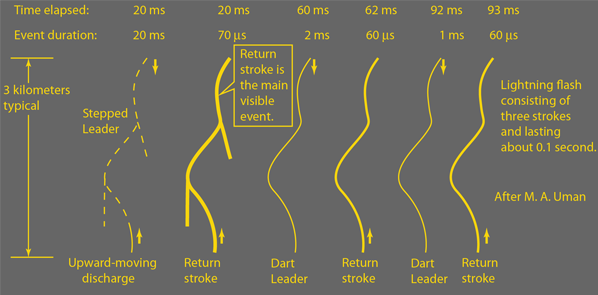Lightning Time Sequence

| Discussion of lightning flashes |
Lightning concepts
Reference
Uman
| HyperPhysics***** Electricity and Magnetism | R Nave |
Lightning flashes and strokesThe term lightning flash is used to describe the entire discharge, which takes on the order of 0.2 seconds. But a flash is usually made up of several shorter discharges which last less than a millisecond and which repeat rapidly enough that the eye cannot resolve the multiple events. These individual discharges are called strokes. Sometimes the strokes are separated enough in time for the eye to resolve them, and the lightning appears to flicker.
|
Index Lightning concepts Reference Uman | ||
|
Go Back |
Lightning Time Sequence
|
Index Lightning concepts Reference Uman | ||
|
Go Back |
Lightning VoltagesWilliams says a typical lightning bolt bridges a potential difference (voltage) of several hundred million volts.
|
Index Lightning concepts Reference Williams | ||
|
Go Back |
Lightning CurrentWilliams says that a typical lightning bolt may transfer 1020 electrons in a fraction of a second, developing a peak current of up to 10 kiloamperes. According to Uman, the German scientist Pockels discovered that basalt rock in the vicinity of lightning strikes was magnetized and deduced currents on the order of 10,000 amps in 1897. Ampere's law allows you to deduce the current in a wire from the measurement of the magnetic field at some radius from the wire. Pockels presumably had measured the magnetizing effects of large currents on basalt and was able to scale those experiments to estimate the current associated with the lightning. Based on that principle, magnetic links are widely used for the measurement of the lightning currents. Most measurements have been in the range 5,000 to 20,000 amps but a famous strike just before the Apollo 15 launch in 1971 was measured at 100,000 amperes by magnetic links attached to the umbilical tower. Currents over 200,000 amps have been reported. One could envision a magnetic detector based on both Ampere's law and Faraday's law which could give you an estimate of lightning current provided you had a measurement of the distance from the detector to the lightning strike point. If you set up a coil of wire in a vertical plane, then the rate of change of magnetic field through the coil would generate a voltage. If you could sum (integrate) the current generated by that voltage, you could calculate the charge transferred in the lightning strike. With several such detectors in an area, you could model the location as well as the charge associated with the strike. Most commonly, the lightning current ceases in about a millisecond for a given stroke, but sometimes there is a continuing current on the order of 100 amps following one or more of the strokes. This is called "hot lightning" and it is the cause of lightning fires according to Uman. The temperatures of lightning are 15,000-60,000°F for both "cold" and "hot" lightning - it is the continuing current that starts some 10,000 fires per year in the U.S. in the estimation of Uman.
|
Index Lightning concepts References Uman Williams | ||
|
Go Back |
Lightning PowerWilliams says a moderate thunderstorm generates several hundred megawatts of electrical power.
|
Index Lightning concepts Reference Williams | ||
|
Go Back |
Lightning DestructionThe following data is from an Atlanta Journal article
Lightning has killed 6,000 persons in the United States in the past 34 years. In 1990, 74 persons were killed and 252 more were injured. Florida is the most dangerous state with 14 killed and 27 injured in 1990. In 1987 an Atlas-Centaur rocket was struck by lightning on launch and had to be destroyed. |
Index Lightning concepts Reference Baseden | ||
|
Go Back |